
* The Aerospatiale company of France became a global player in the helicopter market through its popular "Alouette" series of light helicopters. Following up on this success, in the 1970s the firm developed a series of rotorcraft, including a new light helicopter named the "Ecureuil (Squirrel)", which proved popular as well and remains in production with Eurocopter / Airbus Helicopters, Aerospatiale's successor firm. This document provides a history and description of the Ecureuil family, including the "EC120 / EC130" follow-ons. A list of illustration credits is included at the end.
* In the early 1970s, the Aerospatiale firm of France began work on a light utility helicopter to replace the company's popular Alouette series of rotorcraft. The result was the "AS350", with first flight of the initial prototype, powered by an Avco Lycoming LTS 101 turboshaft engine, on 27 June 1974. A second prototype, powered by a Turbomeca Arriel 1A turboshaft, followed on 14 February 1975. The Lycoming engine fit was intended for sales in North America, while the Turbomeca engine fit was for Europe and elsewhere. The Turbomeca-powered line ended up predominating, with the initial production "AS350 B Ecureuil (Squirrel)" being certified in late 1977 and deliveries in 1978. It was offered in a variety of fits for applications such as emergency medical services and police work.
The AS350 B was powered by an Arriel 1B turboshaft providing 480 kW (640 SHP) and was of conventional configuration, with a three-blade fiberglass main rotor coupled to a fiberglass / elastomer "Starflex" hub; a two-blade tail rotor on a tailfin, with a ventral fin below; and skid landing gear. The Ecureuil featured a relatively high proportion of plastic and fiberglass assemblies.
The Ecureuil had two seats in front and a bench seat for up to four in the back, with a default door scheme of a single big forward-hinged door in front on each side. An alternate door scheme, with a smaller cockpit door forward and a rear-sliding main door on each side, was also offered. It is unclear if the four-door option was available on the original AS350 B, this scheme being associated with the AS550 military variants of the Ecureuil -- discussed later -- but it is not unusual with later AS350 civil variants. There was a baggage hold in the rear, with a top-hinged door on the right.
The Ecureuil was designed to be reliable, economical to operate, and relatively quiet. Ironically, the Alouette series proved to be resilient, with the modernized Gazelle variant continuing to sell well, and the Ecureuil ended up complementing its sales.
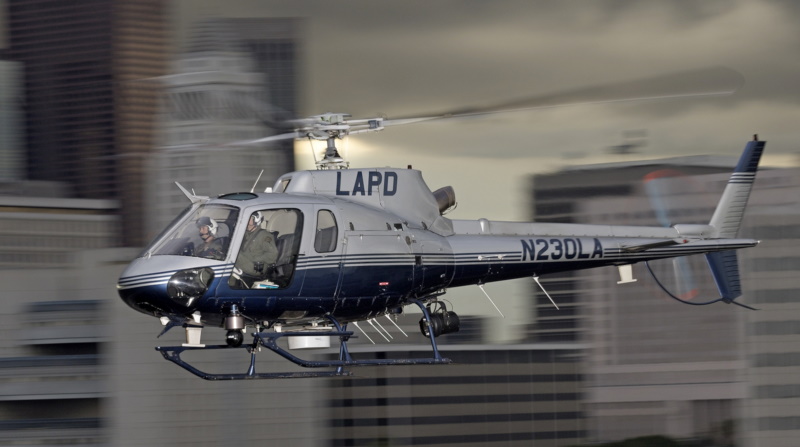
The AS350 B led to a series of refined variants, the first being the "AS350 B1", which featured new, wider-chord rotor blades -- obtained from the twin-engine AS355 series, discussed below -- and an uprated Arriel 1D turboshaft with 440 kW (685 SHP). The improvements raised take-off weight by 150 kilograms (330 pounds) and gave better "hot and high" performance. The AS350 B1 set records in its class. Initial deliveries were in 1986.
As with the AS350 B, the AS350 B1 was offered in a range of fits for different applications, with the increased lift capacity permitting to be used in the firefighting role as the "AS350 Firefighter". It was fitted with taller landing gear and a belly tank designed by Conair, with a capacity of 700 liters (185 US gallons); the first customer was the French Securite Civile.
Sources also indicate an "AS350 BA" variant, which was effectively an AS350 B, with the Arriel 1B engine, but fitted with the wide-chord blades. It emerged in the early 1990s. It may have just been an upgrade for existing AS350 Bs, or a limited production machine for specific user requests, but details are unclear.
In the late 1980s, the AS350 B1 was replaced in turn on the production line by the "AS350 B2", which was generally similar to the AS350 B1 but was fitted with a further uprated Arriel 1D1 turboshaft providing 540 kW (725 SHP). It was sold in North America as the "SuperStar".
The UK ordered a special modification of the AS350 B2 with minor changes for military training, with this subvariant designated the "AS350 BB" and naturally named the "Squirrel". They were provided for both Royal Air Force and British Army Air Corps training as the "Squirrel HT.1" and "Squirrel HT.2" respectively -- the primary difference being that the HT.2 had a night vision goggle (NVG) compatible cockpit.
As a complement to the AS350 B2, an "AS350 B3" was introduced to provide greater power for "hot and high" operations, as a replacement for the "Lama" high-altitude variant of the Alouette. The AS350 B3 was fitted with an Arriel 2B turboshaft, with full authority digital engine controls (FADEC) and providing 630 kW (845 SHP) take-off power. The engine gearbox was uprated to handle the increase in power; a wider-chord tail rotor was added as well.
___________________________________________________________________
AIRBUS HELICOPTER AS350 B3 ECURIEUL:
___________________________________________________________________
main rotor diameter:
10.69 meters (35 feet 1 inch)
fuselage length:
10.93 meters (35 feet 10 inches)
footprint length:
12.94 meters (42 feet 6 inches)
height (tail):
3.14 meters (10 feet 4 inches)
empty weight:
1,175 kilograms (2,590 pounds)
MTO weight:
2,250 kilograms (4,960 pounds
max cruise speed:
250 KPH (155 MPH / 135 KT)
service ceiling:
5,280 meters (17,325 feet)
hover ceiling in ground effect:
3,535 meters (11,600 feet)
hover ceiling out of ground effect:
2,880 meters (9,450 feet)
range:
640 kilometers (400 MI / 345 NMI)
___________________________________________________________________
The AS350 B3 also introduced a new "glass cockpit" with dual color flat-panel displays; presumably the new cockpit arrangement was also offered for the AS350 B2. Initial flight of the AS350 B3 was on 4 March 1997, with deliveries beginning in 1998.
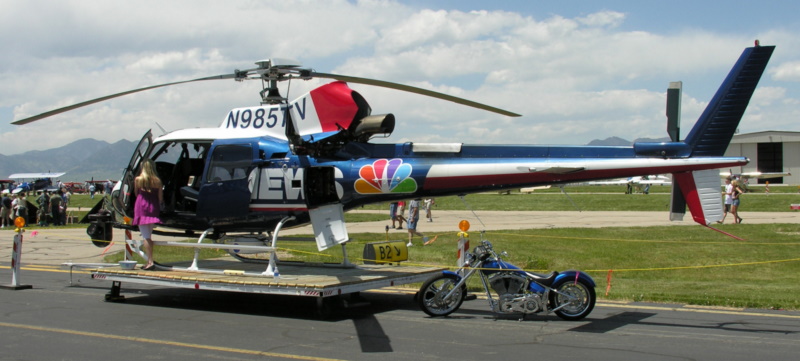
In 1992, the helicopter division of Aerospatiale merged with the German Messerschmitt-Boelkow-Blohm firm to form "Eurocopter", which would later become part of the "European Aerospace & Defense Systems (EADS)" group. EADS would become the "Airbus Group" in 2014, with Eurocopter renamed "Airbus Helicopters"; the 21st-century name is used in the text below for simplicity.
The Ecureuil remains a component of Airbus Helicopter product line, being sold with possible options such as an external sling, rescue host, inflatable flotation gear, video camera, searchlight, imaging turret, and agricultural spraytank. The most recent version of the Ecureuil was the "AS350 B3e" -- an enhanced AS350 B3 -- with initial deliveries in 2011. The AS350 B3e featured an Arriel 2D engine, with similar power ratings to the Arriel 2B, but with dual FADEC, an engine data recorder, and other enhancements to improve reliability and reduce maintenance overhead.
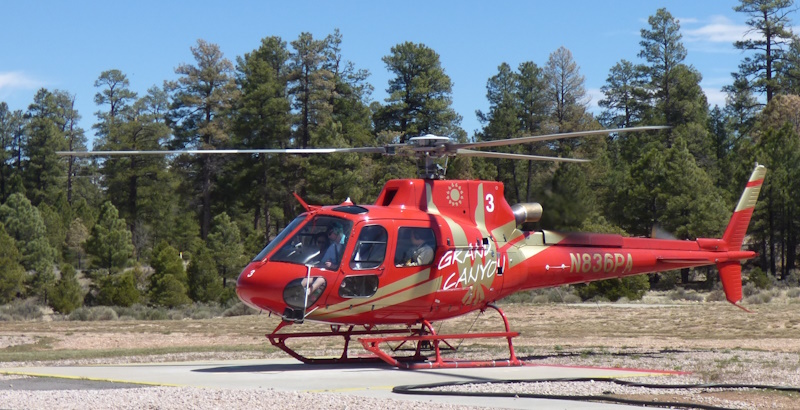
The AS350 B3e also featured updated cockpit avionics, flight controls, and hydraulic system. The AS350 B2 and AS350 B3e remain in production -- though the AS350 B3e has been redesignated "H125". Airbus is working on a hybrid-electric successor that will have 40% lower fuel consumption, with an H125 to be fitted with a hybrid power system. Not much has been said about this effort as of late.
* The Avco Lycoming-powered variants of the AS350 were developed in parallel with the Turbomeca-powered variants, with the "AS350 C AStar" introduced in 1978. It was powered by an Avco Lycoming LTS101-600A2 turboshaft providing 460 kW (615 SHP). It was replaced in 1978 by the "AS350 D AStar", which was equivalent to the AS350 B2 and powered by an LTS101-600A3 turboshaft with 460 kW (615 SHP). However, it appears that the Lycoming powerplant proved unsatisfactory, and though the AStar continues to be sold in the USA, now it's just a rebadged Turbomeca Ecureuil. Third-party upgrades are available for older AS350 Ecureuils, offering updated engines or avionics.
* In 1978, work began on a twin-engine derivative, the "AS355 E Ecureuil 2", the twin engines providing greater safety and lift capacity. Initial flight of the first of two prototypes was on 28 September 1979. The result was very similar to the AS350 but was powered by twin Allison 250-C20 turboshafts providing 315 kW (420 SHP) each. In North America, the Ecureuil 2 was sold as the "Twinstar". The AS355 E was followed by:
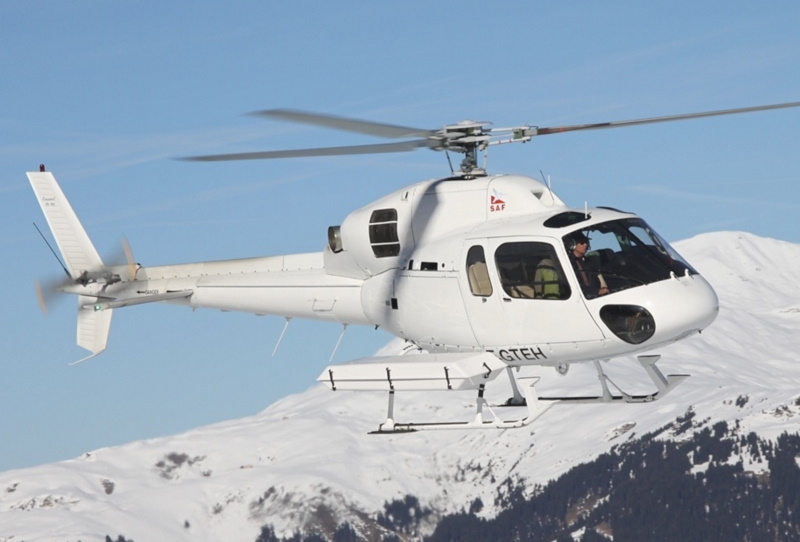
Specs of the AS355 N were very similar to those of the AS350 B3, dimensions being effectively identical, though the AS355 N's empty and MTO weight were about 15% greater. Other than the engine fit, there were some detail differences, for example three baggage holds instead of one. Optional gear was much the same as for the AS350. The twin-engine variants of the Ecureuil were phased out of production in 2016.
BACK_TO_TOP* While some military forces bought the Ecureuil for training and utility use, sales to armed services didn't pick up until Aerospatiale decided to develop a specific military series. The "AS350 L" was the first specifically military Ecureuil, being effectively an AS350 B1 with the Arriel 1D engine, but with taller landing gear, raising the machine's height by 20 centimeters (8 inches); the sliding door fit described above; extended instrument fit; a stores pylon on each side, bolstered with airframe reinforcements for weapons carriage and firing; plus provision for armored seats, cable cutters, and combat avionics such as defensive countermeasures systems and optical / infrared imager turrets.
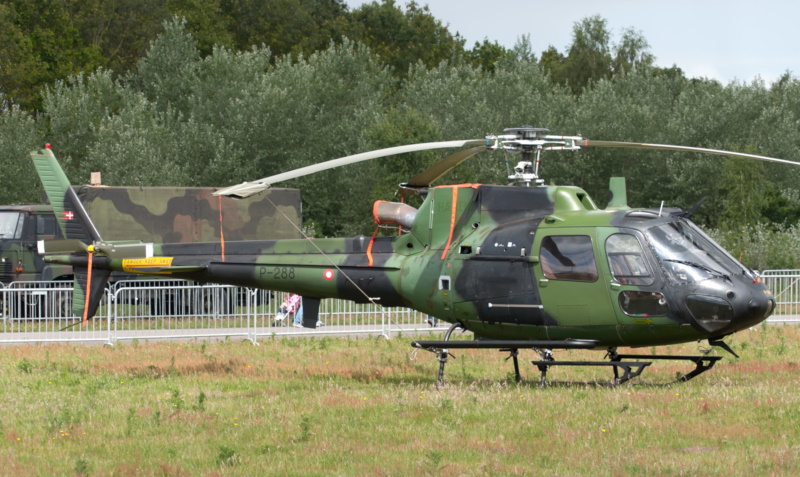
Initial flight of the AS350 L was in March 1985, with deliveries beginning in 1986. It was followed by the "AS350 L2", which was renamed "AS550 U2" in 1990, the decision having been made that the military variants needed their own product line code, as well as a new name: "Fennec (Desert Fox)". The AS550 U2 was actually the general utility version, with other subvariants featuring different equipment fits and suffixes:
An improved "AS550 U3" was introduced to replace the AS550 U2, the new variant featuring the Arriel 2B engine of the AS350 B3; of course "AS550 A3", "AS550 C3", "AS550 M3", and "AS550 S3" subvariants were offered as well.
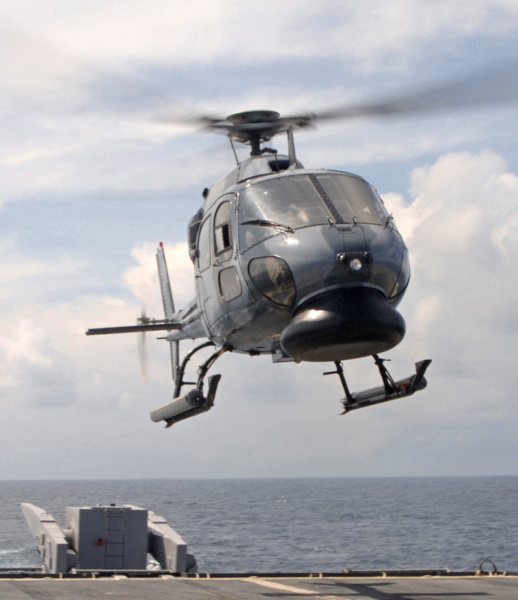
* The twin-engine AS355s were given a similar military makeover. The French Air Force was an early user, obtaining eight AS355 F1 civil machines with Allison engines and militarizations, particularly the capability to carry the side-mounted GIAT 20-millimeter cannon. However, the military versions quickly went on to the fully-militarized "AS555" series, with TM 319 Arrius 1A engines as per the AS355 N. AS555 configurations included:
As mentioned earlier, the AS555 twins are out of production. The single-engine military Fennec is still being sold, in the form of the "H125 M", with the Arriel 2D engine. The H125 M can be fitted with the Airbus "HForce" modular weapons system, with mission computer; imaging turret with laser target designator; helmet-mounted sight; and carriage of a wide range of weapons and munitions, including laser-guided munitions. In 2023, Airbus announced enhanced H125 M variants, including the "AH-125" dedicated attack variant and the "MH-125" military utility variant. For the moment, they seem to be catalog offerings, actual production pending on orders.
* The following table summarizes Ecureuil / Fennec variants:
* There has been substantial foreign license production of the Ecureuil family. Helibras of Brazil, a joint venture of Aerospatiale and several Brazilian firms established in the late 1970s, built the Ecureuil under license as the "Esquilo" -- Portuguese for "Squirrel", of course. Sales were good, with deliveries not merely to Brazilian customers but to other buyers all over South America, particularly military users. The Brazilian-branded Ecureuils ended up with a confusing list of designations:
Helibras also now assembles the H125 M, with a number having been obtained by the Brazilian military for training. Along with sales of Brazil-built machines, Helibras handles regional sales of Airbus Helicopter machines not built in Brazil.
In 2010, the Brazilian Army initiated an upgrade program with Helibras for its machines, to involve a new glass cockpit with three large color displays; new communications and navigation systems; an automatic flight control system; more armor; and new seats to provide improved crash protection. The first of 36 machines to be upgraded was redelivered in early 2015, the last to be redelivered in 2018. Brazilian Fennecs have more recently been upgraded to improve their armament and combat avionics systems.
* The Ecureuil is also built in China by the Change / CHAIG organization as the "Z-11". Initial flight of a Chinese-production machine was in 1997; the initial production variant was apparently equivalent to the AS350 B2, with an Arriel 1D turboshaft, license-built as the WZ8D, but featured a longer and sharper nose. It was followed in 2003 by the "Z-11MB1" with an Arriel 2B1A turboshaft. The Z-11 series is offered in various civil and military configurations, but no twin-engine variant has appeared just yet.
BACK_TO_TOP* In 1992, Aerospatiale began to investigate a new entry-level single-engine helicopter, initially designated the "P120L". The company also began a hunt for cost-sharing partners to help fund development, with Harbin Aircraft Manufacturing Company (HAMC) of China and Singapore Technologies Aerospace (STA) signing up. Formal development of the new helicopter began in early 1993, the same year Aerospatiale became part of Airbus Helicopter, with a tri-national design team working out of the Airbus Helicopter facility at Marignane, France. The first prototype of the "EC120 Colibri (Hummingbird)", as the new helicopter was designated, performed its initial flight on 9 June 1995 -- with "EC" standing, of course, for "Eurocopter", though that designation is no longer meaningful. A second prototype took to the air on 17 July 1996. Initial certifications followed in 1997, with initial deliveries in 1998.
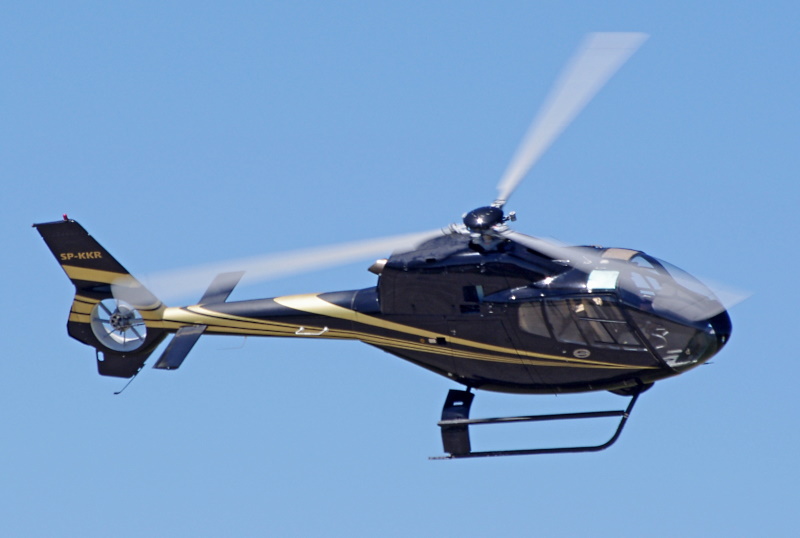
* As introduced, the appearance of the EC120 B -- as the initial production variant was designated -- did not immediately suggest much relationship to the earlier Ecureuil series of helicopters. It shared much of the technology of the older series, including tailboom, engines, power transmission, and gearbox, but featured a new "widebody" cabin and also an eight-blade "fenestron" (enclosed) tail rotor. The widebody cabin appears to have due to a bit of "cross pollination" with the helicopters designed by the German MBB firm, the other ancestor of Airbus Helicopter.
The Colibri could carry a pilot, with 3 or 4 passengers or a stretcher with a medical attendant. It was designed with relatively quiet operation in mind -- the tail rotor blades were unevenly spaced to reduce noise. The Colibri was powered by a Turbomeca Arrius 2F turboshaft engine with 375 kW (505 SHP) for take-off, driving a three-blade rotor with composite blades and a Spheriflex titanium hub. The fuselage was built of light alloy and composites and featured twin landing skids. The EC120 B had a partial "glass cockpit" with twin flat-panel displays. Options included flotation gear and a searchlight.
___________________________________________________________________
AIRBUS HELICOPTER EC20 B COLIBRI:
___________________________________________________________________
main rotor diameter:
10 meters (32 feet 10 inches)
fuselage length:
9.60 meters (31 feet 6 inches)
footprint length:
11.52 meters (37 feet 9 inches)
height (tail):
3.50 meters (11 feet 6 inches)
empty weight:
960 kilograms (2,117 pounds)
MTO weight:
1,800 kilograms (3,969 pounds)
max cruise speed:
228 KPH (142 MPH / 123 KT)
normal cruise speed:
191 KPH (119 MPH / 103 KT)
service ceiling:
5,365 meters (17,600 feet)
hover ceiling in ground effect:
2,820 meters (9,250 feet)
hover ceiling out of ground effect:
2,320 meters (7,600 feet)
range:
732 kilometers (455 MI / 395 NMI)
___________________________________________________________________
Airbus Helicopter handled overall design, engineering, and integration of the Colibri, and produced the drive train, avionics, and electrical system. HAMC had a 24% share and produced the fuselage, including fuel system and canopy. STA had a 15% share and produced the tailboom, access doors, and windshields.
The EC120 is now known as the "H120", with HAMC-built machines being designated "HC120". No specific military variant is on offer. The European Community is now working on a "Clean Sky" program for environmentally friendly aircraft operations, with the effort including a "Green Rotorcraft (GRC)" investigation. One aspect of GRC was fit of an H120 with a lightweight, fuel-efficient turbocharged high-compression kerosene-fueled piston engine, with flight tests in 2015 and 2016. It appears that interest has moved on to a hybrid-electric scheme, as mentioned earlier.
BACK_TO_TOP* The Colibri was well-received by customers, and so Airbus Helicopter went on to develop a more capable derivative. Initial studies were conducted in 1998, and the initial prototype of the "EC130", as it was designated, performed its first flight on 24 June 1999. The second prototype flew in September 2000, with international certifications obtained by the end of the year. Initial customer delivery was in 2001.
The EC130 B4 -- as the initial production version was designated -- was very similar to the EC120 but larger, with 23% more cabin space and greater load capacity. It carried a pilot plus 6 or 7 passengers, or 1 or 2 stretchers with a medical attendant. It had an external sling attachment with a maximum load capacity of 1,160 kilograms (2,558 pounds). The EC130 B4 was powered by a single Turbomeca Arriel 2B1 turboshaft, with a dual channel FADEC and 632 kW (847 SHP) take-off power, driving a three-blade composite rotor and a fenestron tail rotor.
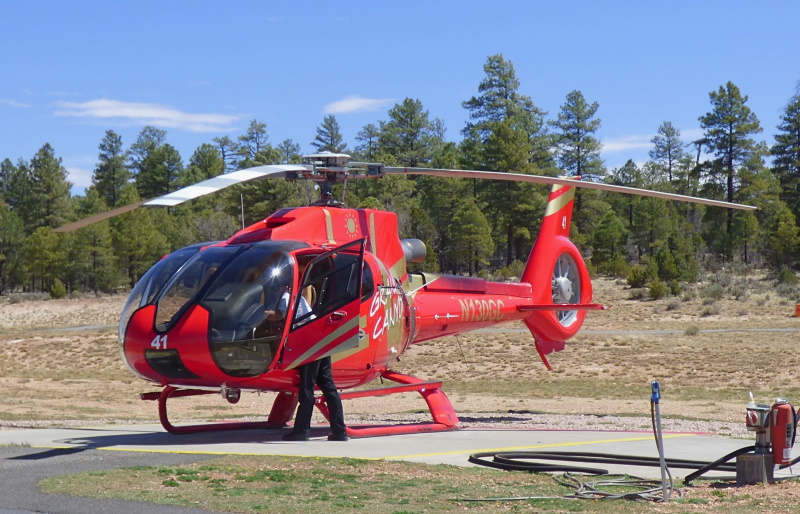
The EC130 B4 was even quieter than the EC120, since it was designed partly with the tourism market in mind and met the strict noise requirements set for the US national parks. It had a heavy-duty air-conditioning system to keep tourists cool, and the pilot sat on the left, not on the right as is traditional -- a change driven by feedback from sightseeing and medevac operators.
The EC130 B4 featured assemblies from the EC120, including doors and canopy; engine, drivetrain, rotor, and hydraulics from the Ecureuil series; and new assemblies, such as a metal tail boom and new landing gear. It could be a bit difficult to tell an EC130 from an EC120; one of the main recognition features was that the EC130 had a three-part windscreen, with a center panel, while the EC120 had a two-part windscreen. The EC130 also had a "fat" tailfin that clearly differed from that of the EC120.
___________________________________________________________________
AIRBUS HELICOPTER EC130 B4:
___________________________________________________________________
main rotor diameter:
10.69 meters (35 feet 1 inch)
fenestron diameter:
1 meter (3 feet 6 inches)
fuselage length:
10.68 meters (35 feet)
footprint length:
12.64 meters (41 feet 6 inches)
height (tail):
3.61 meters (11 feet 10 inches)
empty weight:
1,360 kilograms (3,000 pounds)
max loaded weight:
2,800 kilograms (6,174 pounds)
fast cruise speed:
260 KPH (160 MPH / 140 KT)
service ceiling:
7,010 meters (23,000 feet)
hover ceiling in ground effect:
3,100 meters (10,165 feet)
hover ceiling out of ground effect:
2,540 meters (8,325 feet)
range:
640 kilometers (400 MI / 345 NMI)
___________________________________________________________________
In 2012, Airbus Helicopter unveiled the "EC130 T2", which retained the same external appearance but featured substantial airframe changes and a revised interior, along with an active vibration control system, improved serviceability, and a modernized control layout. In particular, it featured an Arrius 2D engine and an uprated drivetrain to handle the additional power, providing heavier take-off weight and higher speed, along with lower fuel consumption.
Production deliveries of the EC130 T2 began in 2013 -- the variant being redesignated the "H130" after the formation of Airbus Helicopters. It has been assembled in both China and Australia. As with the H120, there was no specific military variant of the H130. In 2018, Airbus unveiled an executive configuration of the variant, the Airbus Corporate Helicopters 130 or "ACH130", with a VIP interior. One H130 is being flown by Airbus for tests & trials, being known as a "Flightlab", with an emphasis on new flight safety technologies.
Overall total sales of the Ecureuil family are running at about 4,000 machines, with users in at least 70 countries. The Ecureuil has been and continues to be a nice little earner for Airbus Helicopter.
BACK_TO_TOP* Helicopters are not over-documented, and so this writeup was put together by scanning through all the JANE'S ALL THE WORLD AIRCRAFT volumes I could find that mentioned these machines, as well as searches of the internet for useful clues. The Airbus Helicopter website had a fun little interactive utility that allowed me to pick semi-custom paint schemes for the EC130.
This document started life covering both the Aerospatiale Dauphin / Panther medium helicopter along with the Ecureuil, but it got too long and I had to split them into separate documents.
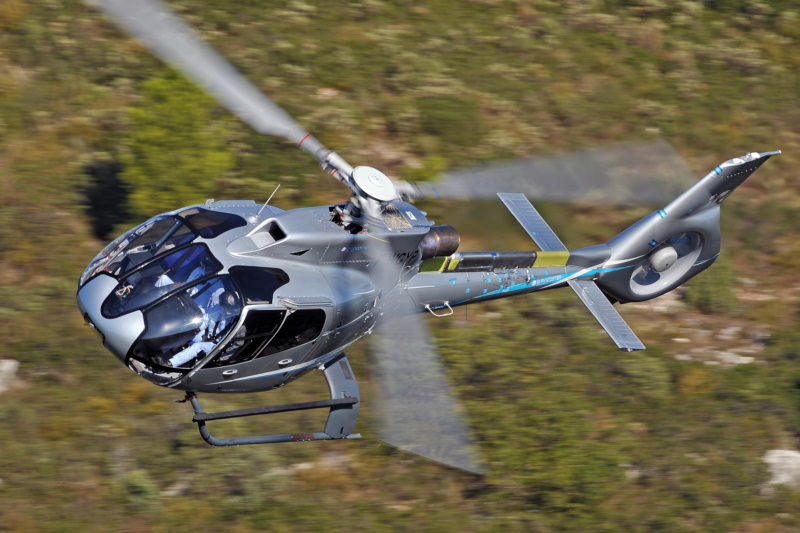
* Illustrations credits:
* Revision history:
v1.0.0 / 01 oct 09 / Initial release with both Ecureuil & Dauphin. v1.0.1 / 01 may 10 / Minor update. v2.0.0 / 01 feb 11 / Split out materials on Dauphin. v2.0.1 / 01 jan 13 / Added EC130 T2. v2.0.2 / 01 dec 14 / Changed "Eurocopter" to "Airbus Helicopter". v2.0.3 / 01 nov 16 / Review & polish. v3.0.0 / 01 oct 18 / Updated variant designations. v3.1.0 / 01 oct 20 / Illustrations update. v3.2.0 / 01 aug 22 / Review, update, & polish. v3.2.1 / 01 aug 23 / Review, update, & polish.BACK_TO_TOP
